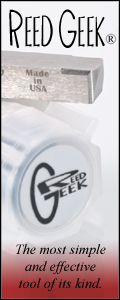Getting Started Page 4
It is very important that you establish a regular practice routine. This routine should be carried out at least five days a week. You should practice for a period of twenty to thirty minutes, at the minimum. It is sometimes helpful to try and find a set time every day for this practice session. It is much more beneficial to practice on a regular basis than to try and skip two or three days and try to make up for lost time by practicing for two hours once a week. It has to do with muscle memory. Your muscles (including the one between your ears) recall the actions they were called upon to perform less than twenty four hours ago. When you do this every twenty four hours, the effect becomes cumulative. It’s like building a house with a good, solid foundation. If you have a solid foundation, then whatever you put on top is going to last. So by practicing a little each day, you are “layering” these practice sessions on top of each other. Pretty soon, you’ve got a good base on which to build.I would suggest your routine goes like this:
Long Tones Five minutes. Start in the middle of the horn and work your way up and down. See link for details.
Scales and Arpeggios Ten minutes. A large percentage of all music can be boiled down to scales, pieces of scales, or patterns of scales. Play them as musically as possible. You play like what you practice like, or, as ye practice, so shall ye play.
Pentatonic and Blues Scales These scales are some of the most useful and versatile scales for all styles of improvisation. They can be very simple or very complex, depending on the level of mastery.
Method Books Ten minutes. Get a good method book. Practice it religiously. I tell my students that the most important thing that a good method book teaches you is how to play your horn correctly. As a side benefit, it also teaches you how to read music. A good method book is a good way to logically progress. See the link for some suggestions.
Tunes Ten minutes. Start playing tunes as soon as possible. Anything that suits your fancy. Jazz standards, movie themes, show tunes, whatever. This is what it’s all about, after all! See link for partial list of tunes you should know.
Fun Stuff Ten minutes. This is up to you. Whatever it is you feel like doing, especially if you’re not playing tunes yet. Trying to play simple tunes by finding the notes on your horn, for example, is an excellent way to start working on your ear training.
Cleaning your instrument
When you get through with this practice routine you will want to clean your sax before packing it away. First, after practicing, take the reed off the mouthpiece and wipe it dry and put it back in the holder you got it from. Now you don’t have to worry about breaking it. Take the mouthpiece off the neck and wipe the outside clean and with a pull through rag or some kind of a mouthpiece “mouse” clean the inside of the mouthpiece thoroughly, put the cap on it and put it back in the case. Every so often, say every week, depending on how much you play it, you should clean out the mouthpiece with warm water, a mild detergent (toothpaste or dishwashing soap, for example), and an old toothbrush or some sort of bottle brush. For the neck you will want a pull through cleaner or a “pad saver” for the neck. These are both available at most music stores. Some of my students have made their own. For the body of the horn I would recommend the use of the “Pad Saver.” Push the pad saver in to the body of the saxophone, give it a twist and presto! It is fine to keep the pad saver in the horn while it is stored. You will find some don’t share that opinion but I base mine on thirty two years plus of keeping the pad saver in the horn. I actually bought my old soprano from the inventor of the pad saver. That would be Walt De Hope who used to own The House of Woodwinds in Oakland, Ca. The main idea behind cleaning your instrument is to keep it dry and free from moisture. If you have a nice shiny horn, you will also want to clean and polish the outside of the horn to keep the oils from your skin and sweat from playing it so much, from building up on the instrument. Use a polishing cloth designed for that purpose. A clean horn is a happy horn!




